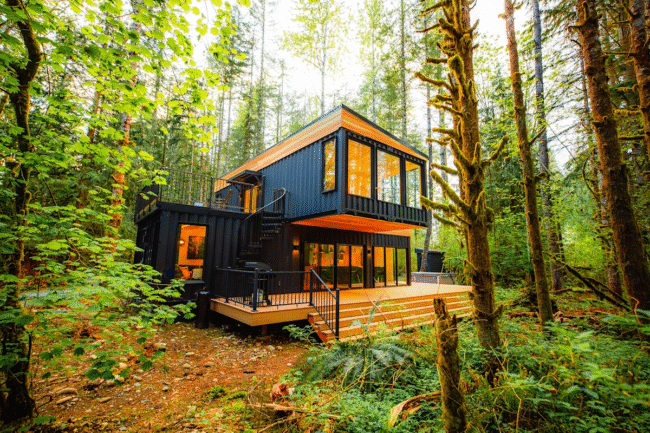
In the modern world, sustainability has become more than just a catchphrase; it’s a necessary approach to living that considers the long-term impact of our actions on the planet. One of the innovative solutions that are at the forefront of eco-friendly living is the emergence of container homes. These structures, built from repurposed shipping containers, are not only cost-effective but also significantly reduce the carbon footprint associated with traditional construction.
The Sustainability of Container Homes
Container homes have garnered immense popularity among those looking to reduce their environmental impact while still living in a modern, comfortable space. These housing alternatives demonstrate how recycling and innovative design can lead to sustainable living solutions that challenge the norms of the building industry.
At first glance, the use of shipping containers for housing may seem unconventional, but the benefits speak for themselves. Container homes are often lauded for their structural strength, as containers are designed to withstand harsh weather conditions and heavy loads. This makes them incredibly durable and a viable option for residential construction.
Reducing Carbon Emissions in Construction
Constructing a traditional home requires a substantial amount of raw materials like timber, concrete, and steel — which contributes heavily to the carbon emissions associated with the manufacturing and transportation processes. In contrast, repurposing shipping containers as livable spaces makes use of existing materials, significantly minimising the environmental footprint of construction.
Economic Benefits
Aside from environmental advantages, container homes can also provide economic benefits. By using recycled containers, the cost of raw materials reduces dramatically. Furthermore, the modular nature of container construction can shorten building times and therefore labour costs, making it an economically viable option for many individuals and families looking to build a new home.
Creative Design Freedom
An often-underrated aspect of container homes is the level of design freedom they offer. Without the shape and size constraints of traditional building methods, containers can be stacked and positioned in various configurations, delivering unique, customised living spaces. Innovative insulation and cladding materials can be used to enhance energy efficiency, further substantiating the eco-friendly ethos of container living.
Community and Urban Planning
Urban planners have also begun to recognise the potential of container homes in addressing housing crises in densely populated cities. These homes can be rapidly deployed to create affordable housing options, reflecting a pragmatic and sustainable approach to urban development.
Challenges and Considerations
Despite the clear environmental and economic benefits of container homes, there are several challenges to consider. Zoning laws and building regulations can vary widely across regions, and in some cases, it can be difficult to obtain the necessary permits for container housing. It is essential that individuals interested in pursuing this option research their local regulations thoroughly.
Insulation and Temperature Control
One significant challenge with container homes is ensuring effective insulation and temperature control. Because metal conducts heat, a container home can become uncomfortably hot or cold without proper insulation. However, with the right materials and design, these issues can be easily mitigated to create a comfortable living environment.
Integrating Technology and Innovation
The beauty of container homes is not limited to their sustainability or cost-effectiveness; they also serve as a perfect platform for integrating modern technology. From solar panels to smart home systems, container homes can be equipped with the latest innovations to enhance livability and further reduce the ecological footprint of their occupants.
Building a Community of Sustainable Mindsets
Choosing to live in a container home is not just a personal choice; it often reflects a commitment to a broader community of like-minded individuals who prioritise sustainability. This sense of community can lead to the sharing of knowledge, resources, and a collective effort to promote eco-friendly living practices.
Looking Towards the Future
As resources become scarcer and environmental concerns grow, sustainable living solutions such as container homes are no longer just alternative housing options, but necessities for our planet’s future. By embracing these innovative methods, individuals can make a significant impact in the campaign for a greener and more sustainable world.
Conclusion
Container homes represent a significant step towards achieving a sustainable lifestyle without sacrificing comfort or style. By repurposing materials, reducing waste, and integrating green technologies, these structures offer a viable blueprint for eco-friendly living. For those looking to embark on the journey of constructing a sustainable home, container homes could be the innovative solution that aligns with both their environmental and economic goals. As we move further into a world where sustainability is at the forefront, it is clear that container homes will play a pivotal role in shaping the future of residential living.
The Role of Consumers and Builders
Finally, the decision to opt for a container home is not solely in the hands of the consumer. Builders and architects have a significant role to play in advocating and educating about the benefits of container homes. Only through a combined effort between consumers demanding sustainable options and builders providing them can we ensure a greener future for residential construction. Container homes are more than a trend; they are a testament to human ingenuity and a reminder that we can live comfortably while still being kind to our planet.
